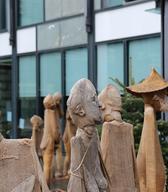Migrations
The Slovene Ethnographic Museum as a place of dialogue between cultures, at this historic time of mass migration calls for knowledge and understanding of our own and other cultures. We need to rethink the relationship between human universals and cultural diversity, and to ask what unites rather than divides us.
Museums and migration
How to address this questions (of migration) in a museum?
- Give a voice to those involved in these processes (the principle - nothing about us, without us),
- Offer artistic visions of universal problems that we are urgently faced with
- Through museum policies in collecting contemporary items.
Framing Equality
Photostories by migrant and Roma women
The exhibited photostories show the challenges faced by migrant and Roma women, one of the most vulnerable social groups, from their viewpoint. The images are the product of empowerment workshops. The creators of the exhibition stem from different cultural environments with the common denominator that they all live in Slovenia.
Migration and the young
Photographic exhibition prepared by students of the Secondary School of Design and Photography, supervised by Manca Juvan. The photographs deal with the experiences of young migrants.
Photographers: Manca Borštnar, Andraž Fijavž Bačovnik, Nina Kranjc, Tin Meštrovič Silvaši, Kristina Žetko.
MIGRATIONS – Love – Vanishing – Welcome
Transmedia exhibition
Transmedia exhbition exploring reasons for migrations – Slovenians abroad and foreign citizens to Slovenia. Photographers: Manca Juvan, DK and Fernanda Prado Verčič.
More about the exhibition on a web page www.migracije.si
Waiting
Statues
Group project Waiting – students of The Academy of Fine Arts and Design, University of Ljubljana, Slovenia. Sculptors: Katja Bogataj, Polona Černe, Pavel Ekrias, Neža Jurman, Ana Kerin, Miha Makovec, Barbara Pintar in Lan Seušek, mentor prof. Alen Ožbolt.
Razor fence – items from the refugee centre
Exhibition of objects from a refugee centre
A small team of volunteers from the SEM worked in a refugee centre in Šentilj, handing out clothes to refugees or helping them get medical assistance …
Exhibition of object that used in a refugee centre by volunteers and refugees: overalls, respirators, information leaflets… Also exhibited: a folding bed, a UNHCR blanket and 10 metres of razor fencing, which was placed on the border between Slovenia and Croatia.
The SEM and APIS organized the round table Fortres Europe: from razor fence to human rights about closing borders, human rights, racism and Islamophobia.











